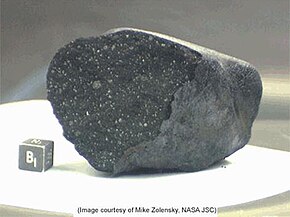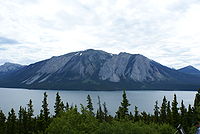Tagish Lake (meteorite)
| Tagish Lake | |
|---|---|
 A 159 gram fragment of the Tagish Lake meteorite | |
| Type | Chondrite |
| Class | Carbonaceous chondrite |
| Group | C2 ungrouped |
| Shock stage | S1 |
| Country | Canada |
| Region | British Columbia |
| Coordinates | 59°42′16″N 134°12′5″W / 59.70444°N 134.20139°W[1] |
| Observed fall | Yes |
| Fall date | January 18, 2000 08:43:42 pst |
| TKW | 10 kg |
The Tagish Lake meteorite fell at 16:43 p.m. on 18 January 2000 in the Tagish Lake area in northwestern British Columbia, Canada.
History

Fragments of the Tagish Lake[1] meteorite landed upon the Earth on January 18, 2000 at 16:43 UT (08:43 local time in Yukon) after a large meteoroid exploded in the upper atmosphere at altitudes between 50 and 30 km with an estimated total energy release of about 1.7 kilotons. Following the reported sighting of a fireball in the in southern Yukon and northern British Columbia, Canada, more than 500 fragments of the meteorite were collected from the lake's frozen surface. Post-event atmospheric photographs of the trail left by the associated fireball and U.S. Department of Defense satellite information yielded the meteor trajectory.[2] Most of the stony, carbonaceous fragments landed on the Taku Arm of the lake, coming to rest on the lake's frozen surface. The passage of the fireball and the high-altitude explosion set off a wide array of satellite sensors as well as seismographs.
Meteoroid
The Tagish Lake meteoroid is estimated to have been 4 meters in diameter and 56 tonnes in weight before it entered the Earth's atmosphere. However, it is estimated that only 1.3 tonnes remained after ablation in the upper atmosphere and several fragmentation events, meaning that around 97% of the meteorite had vaporised, mainly becoming stratospheric dust that was seen as noctilucent clouds to the northwest of Edmonton at sunset, some 12 hours after the event. Of the 1.3 tonnes of fragmented rock, somewhat over 10 kg (about 1%) was found and collected.
Specimens
Tagish Lake is classified as a carbonaceous chondrite, type C2 ungrouped. The pieces of the Tagish Lake meteorite are dark grey to almost black in color with small light-colored inclusions, and a maximum size of ~2.3 kg.[2] Except for a greyish fusion crust, the meteorites have the visual appearance of a charcoal briquette.[3] The fragments were transported in their frozen state to research facilities after they were collected by a local resident in late January, 2000. Initial studies of these fresh fragments were done in collaboration with researchers from NASA. Snowfall covered the remaining fragments until April 2000, when a search effort was mounted by researchers from the University of Calgary and University of Western Ontario. These later fragments were mostly found to have sunk into the ice by a few cm to more than 20 cm, and had to be collected out of meltwater holes, or cut in icy blocks from the frozen surface of Tagish Lake.
Fragments of the fresh, "pristine" Tagish Lake meteorite totaling more than 850g are currently held in the collections at the Royal Ontario Museum and the University of Alberta. "Degraded" fragments from the April–May 2000 search are curated mainly at the University of Calgary and the University of Western Ontario.
Analysis and classification
Analyses have shown that Tagish Lake fragments are of a primitive type, containing unchanged stellar dust granules that may have been part of the cloud of material that created our solar system and Sun. This meteorite shows some similarities to the two most primitive carbonaceous chondrite types, the CI and CM chondrites; it is nevertheless quite distinct from either of them. Tagish Lake has a much lower density than any other type of chondrite and is actually composed of two somewhat different rock types. The major difference between the two lithologies is in the abundance of carbonate minerals; one is poor in carbonates and the other is rich in them.[4]
A portion of the carbon in the Tagish Lake meteorite is contained in what are called nanodiamonds—very tiny diamond grains at most only a few micrometers in size. In fact, Tagish Lake contains more of the nanodiamonds than any other meteorite.[5]
Origin
Based on eyewitness accounts of the fireball caused by the incoming meteorite and on the calibrated photographs of the track which it had left behind and which was visible for about half an hour, scientists have managed to calculate the orbit it followed before it impacted with Earth. Although none of the photographs captured the fireball directly, the fireball path was reconstructed from two calibrated photos taken minutes after the event, giving the entry angle. Eyewitness accounts in the vicinity of Whitehorse, Yukon accurately constrained the ground track azimuth from either side. It was found that the Tagish Lake meteorite had a pre-entry Apollo type orbit that brought it from the outer reaches of the asteroid belt. Currently, there are only eleven meteorite falls with accurately determined pre-entry orbits, based on photographs or video recordings of the fireballs themselves taken from two or more different angles.
Further study of the reflectance spectrum of the meteorite indicate that it most likely originated from 773 Irmintraud, a D-type asteroid.
See also
- 773 Irmintraud, the asteroid that the Tagish Lake meteorite most likely came from.
References
- ^ a b Meteoritical Bulletin Database: Tagish Lake
- ^ a b Brown, Peter G. (2000-10-13). "The Fall, Recovery, Orbit, and Composition of the Tagish Lake Meteorite: A New Type of Carbonaceous Chondrite" (PDF). Science. 290 (5490): 320–325. doi:10.1126/science.290.5490.320. PMID 11030647.
{{cite journal}}: Unknown parameter|coauthors=ignored (|author=suggested) (help) - ^ Geological Survey of Canada. Meteorite fragment photo
- ^ Mittlefehldt, D. W. (2002). "Tagish Lake: a meteorite from the far reaches of the asteroid belt". Planetary Science Research Discoveries. Retrieved 2009-05-02.
{{cite journal}}: Unknown parameter|month=ignored (help) - ^ Grady, Monica M. (2002). "Light element geochemistry of the Tagish Lake CI2 chondrite: comparison with CI1 and CM2 meteorites". Meteoritics and Planetary Science. 37 (5): 713–735. doi:10.1111/j.1945-5100.2002.tb00851.x.
{{cite journal}}: Cite has empty unknown parameter:|month=(help); Unknown parameter|coauthors=ignored (|author=suggested) (help)
- Universe: The Definitive Visual Dictionary, Robert Dinwiddie, DK Adult Publishing, (2005), pg. 222.
- Mittlefehldt, D.W., (2002), Geochemistry of the ungrouped carbonaceous chondrite Tagish Lake, the anomalous CM chondrite Bells, and comparison with CI and CM chondrites, Meteoritics and Planetary Science 37: 703-712. See summary of the article.
